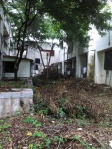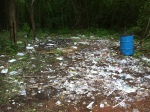 Prof. K K Mishra of our Department of Anthropology is presently away from the University, serving as the Director of the Indira Gandhi Rashtriya Manav Sangrahalaya in Bhopal (and also as the Director General of the Anthropological Survey of India, in Kolkata).
Prof. K K Mishra of our Department of Anthropology is presently away from the University, serving as the Director of the Indira Gandhi Rashtriya Manav Sangrahalaya in Bhopal (and also as the Director General of the Anthropological Survey of India, in Kolkata).
This week, he has brought an exhibition to the Salar Jung Museum, Anugunj, that explores the various creation myths that occur in our diverse indigenous cultures. Hyderabad is in good company- the exhibition that is permanently housed in Bhopal has earlier traveled to Mumbai and to Delhi. I had the privilege of seeing it today, and it was, in a word, stunning.
The Indira Gandhi Rashtriya Manav Sangrahalaya was founded with the aim of preser ving and documenting the disappearing traditions and life-skills as well as with a view to revive as many of them as possible. It aimed at presenting a chronicle of human evolution but with an awareness of the pitfall that threatened a past oriented approach. The museum is spread over 200 acres with an undulating terrain has many open-air exhibitions. The travelling exhibition Anugunj is a component of [their] permanent exhibition and consists mainly of photographs of the exhibits from there. However, it also has fibre replicas of some huge terracotta works as well as smaller versions of the original objects in iron, bronze and terracotta created by the same artists.
ving and documenting the disappearing traditions and life-skills as well as with a view to revive as many of them as possible. It aimed at presenting a chronicle of human evolution but with an awareness of the pitfall that threatened a past oriented approach. The museum is spread over 200 acres with an undulating terrain has many open-air exhibitions. The travelling exhibition Anugunj is a component of [their] permanent exhibition and consists mainly of photographs of the exhibits from there. However, it also has fibre replicas of some huge terracotta works as well as smaller versions of the original objects in iron, bronze and terracotta created by the same artists.
Mythology, besides being the ancient cousin of culture is also a chronicle of its highs and low. Hence a basic understanding of the myths is necessary for knowing a culture. This brings out the importance of this exhibition as well as the reason for its popularity.
In addition to being visually very attractive, this exhibit that occupies a large new room on the third floor of the Salar Jung museum and which has been curated by Shampa Shah (of the IGRMS) explores the creation of the world, various trades and various tribes in a variety of media- painting, terracotta, and metalwork. Being a traveling show, many of the exhibits are photographs or reproductions, but still. It was great to see a large painting by Durgabai Vyam who had come to the UoH last year. Also a terracotta sculpture by the phenomenal- and tragic- tribal artist, Jangarh Singh Shyam.
The exhibition is on for the next three weeks, and given the range of arts on display- from Ao Naga to Saora to Bhil- this is well worth a visit to the Salar Jung Museum. And if things work out, we should be able to catch a glimpse of it on our own campus too…








